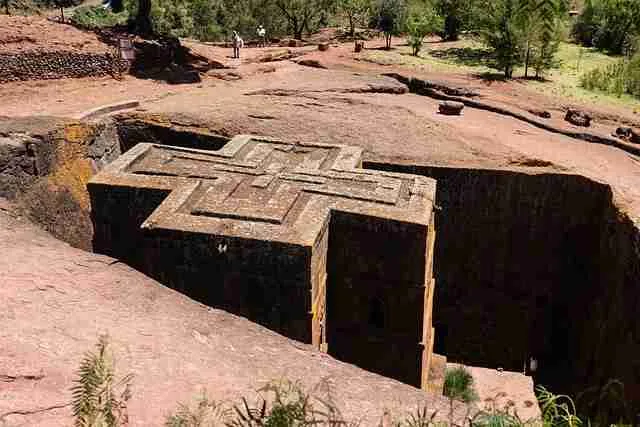Lalibela

Ethiopia - What to see in Lalibela
Lalibela in Ethiopia: A Timeless Pilgrimage Destination
High in the mountains of northern Ethiopia lies Lalibela, a town renowned for its extraordinary rock-hewn churches. Carved directly into solid volcanic rock during the 12th and 13th centuries, these architectural marvels are among the most sacred sites in Ethiopian Christianity and hold UNESCO World Heritage status. Lalibela is not only a place of worship but also a destination that offers history, spirituality, and cultural depth.
The Remarkable Rock-Hewn Churches
The churches of Lalibela are unique in both design and construction. Hewn from living rock in a top-down approach, they are surrounded by deep trenches and courtyards that create an almost subterranean world. This method required immense skill and perseverance, resulting in one of the most impressive feats of medieval engineering.
Inside, the churches reveal intricate carvings and striking artwork. Walls and ceilings are adorned with religious motifs, geometric patterns, and floral designs. Many churches house ancient manuscripts and icons, offering a glimpse into Ethiopia’s spiritual heritage.
Among these sacred structures, Bete Giyorgis stands out. Dedicated to Saint George, Ethiopia’s patron saint, this cruciform church sits in a 15-metre-deep pit and is celebrated for its symmetry and detailed reliefs. Other notable churches include:
- Bete Medhane Alem – The largest monolithic church in the world.
- Bete Amanuel – Famous for its elaborate carvings.
- Bete Mariam – Dedicated to the Virgin Mary and adorned with vivid murals.
- Bete Golgotha – Known for its life-size statue of Christ on the cross.
Lalibela as a Pilgrimage Centre
Lalibela is one of Ethiopia’s most significant pilgrimage destinations. Devotees travel from across the country to worship and participate in religious ceremonies. The most important pilgrimage occurs during Ethiopian Christmas, celebrated on 7 January. During this time, Lalibela transforms into a sea of white robes as thousands gather to sing hymns, chant prayers, and fill the air with incense.
Witnessing this celebration offers visitors a profound cultural experience. The devotion and communal spirit displayed during these ceremonies reflect the deep-rooted faith that has sustained Lalibela for centuries.
Beyond the Churches: Exploring Lalibela
While the rock-hewn churches are the main attraction, Lalibela offers more to explore. The Lalibela Museum houses artefacts from the churches and provides a historical context for the town’s significance. For a taste of local life, the Lalibela Market is ideal. Here, visitors can browse for handicrafts, sample traditional food, and engage with friendly locals.
For those willing to venture further, the Asheten Maryam Monastery sits atop a mountain about an hour from Lalibela. Its cave churches and panoramic views make the hike worthwhile. Another gem is Yemrehana Kristos Church, located two hours away. Built inside a cave and surrounded by forest, it offers stunning scenery and a serene atmosphere.
Practical Tips for Visiting Lalibela in Ethiopia
- Best time to visit: October to May is ideal, as roads are easier to navigate during the dry season.
- Getting there: Lalibela is accessible by domestic flights from Addis Ababa or by road, though journeys can be long.
- Accommodation: Options range from simple guesthouses to comfortable hotels. Book early during festive seasons.
- Dress modestly: When visiting churches, wear clothing that covers shoulders and knees.
- Local etiquette: Photography inside churches may require permission. Always respect worshippers and ceremonies.
Why Lalibela in Ethiopia Should Be on Your Itinerary
Lalibela is a living testament to faith, resilience, and artistry. Its rock-hewn churches remain among the most remarkable architectural achievements in the world, while its vibrant traditions offer insight into Ethiopia’s spiritual heart. Beyond the sacred spaces, the surrounding landscapes and cultural encounters make Lalibela a destination that appeals to history enthusiasts, photographers, and travellers seeking authentic experiences.
If you are planning a journey through Ethiopia, include Lalibela in your itinerary. Whether you come for its architectural wonders, its spiritual significance, or its welcoming community, Lalibela promises memories that will last a lifetime.
